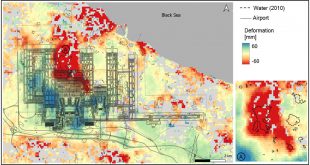Fresenius Environmental Bulletin, 28 (2), 541-547, (2019)
Assessment of The Relationship Between Land Use/Cover Changes and Land Surface Temperature: A case Study of Thermal Remote Sensing
Celik, B., Kaya, S., Alganci, U., Seker, D.Z.
Abstract: Rapid and uncontrolled urbanization is one of the most important land cover change phenomenon, which has important environmental impacts on ecosystem and climate. Due to the urbanization, green areas and natural permeable surfaces transform into non-permeable impervious surfaces, yielding an increase in urban land surface temperatures (LST). This causes an environmental phenomenon called urban heat islands (UHI), where urban temperatures are higher than the surrounding rural areas. Satellite remote sensing technology is an effective tool to monitor and quantify the effects of urbanization process with synoptic viewing capability and high temporal resolution. This study focuses on determining the land surface temperature and land use/land cover (LULC) changes in Istanbul for the last three decades and identifying the relation between these parameters using multi-temporal optical and thermal remote sensing data. The study is conducted using Landsat 5 TM and Landsat 8 OLI/TIR images, which were acquired on June 1984 and June 2017 respectively. In order to assess the land cover change between 1984 and 2017, a vegetation impervious surface-soil (V-I-S) model was applied to the fraction images obtained from linear spectral unmixing process. End-member spectras used in linear spectral unmixing were extracted from ASTER spectral library and resampled to bandpasses of Landsat 5 TM and Landsat 8 OLI data. In addition to V-I-S model outputs, normalized difference vegetation index (NDVI) and normalized difference built-up index (NDBI) images were produced. A maximum-likelihood classification was also performed to multi-spectral bands in order to derive the LULC maps. Water bodies were extracted from imagery using automated water extraction index (AWEI). Thermal infrared bands of Landsat 5 TM and Landsat 8 are used for the derivation of land surface temperatures. The results of the study indicates that, the amount of impervious surfaces substantially increased along with land surface temperatures over three decades.

 CSCRS İTÜ – Center for Satellite Communications and Remote Sensing
CSCRS İTÜ – Center for Satellite Communications and Remote Sensing 